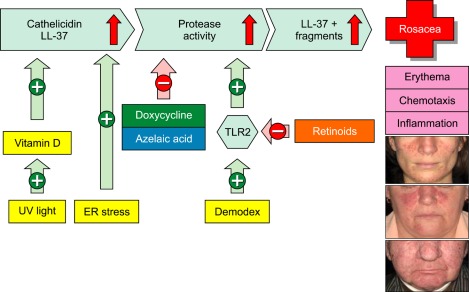Fig. 1.
The role of cathelicidin in the pathogenesis of rosacea and possible therapeutic implications. UV light increases the synthesis of vitamin D which induces cathelicidin expression in keratinocytes. ER stress is an alternative inducer of cathelicidin production. Increased protease activity in rosacea skin is possibly due to demodex mite colonization: Chitin released from mites triggers TLR2 receptor activation and increased protease activity. Subsequently, enhanced protease activity leads to increased cleavage of cathelicidin LL-37 and further fragments. These fragments trigger inflammation, erythema and telangiectasias. Doxycycline, azelaic acid and retinoids mediate their beneficial effects in rosacea possibly by interfering with this pro-inflammatory system through different mechanisms. UV: ultraviolet, ER: endoplasmic reticulum, TLR: Toll-like receptor.

